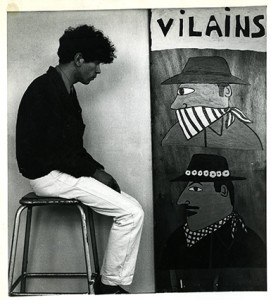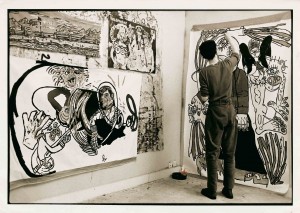“ I have always painted and drawn, and I went to art school when I was 9 years old. My work comes from scribbling rather than from what I learnt at art school. I was rather an average student. I just needed to paint. It was male artists/men who brought me to painting. I can’t tell you the names, but I think you can see it through my paintings sometimes. Basically, I try to be an expressionist of the 1980s.”
“I come from a family of six children, my father was a worker, and my mother used to be a housecleaner. I went to school until the age of 17, and then I entered the Ecole des Beaux-Arts in Sète (Art Academy) for one year, and then moved to the Ecole des Beaux-Arts in Montpellier where I spent five years. I stayed there until I got my diploma. It was during the last three years that I painted the first works that were to become “La Figuration Libre”, as it was named later. Although often confronted by professors, I was pretty free and I was doing what I wanted. I changed my first canvas many times, I painted it over and over again, then I split it into four parts, and then into three parts. I cut them, and burnt one of them. After this work, I really started to paint very freely. My paintings were very colorful, quite violent with a lot of characters often fighting or playing practical jokes on one another, it was really black humor. When I was a child I used to do drawings of battles. I scribbled graffiti on school desks and notebooks. My first paintings were entitled “Battle of cow-boys and Indians”, “Japanese against Americans”, and “Sea Battle”….”
“I have always wanted to create something totally new, and I have always needed to stand out of the crowd. I think of myself as a dandy.”
“I passed my final-year painting exam in Saint-Etienne before a jury, and among them was Bernard Ceysson, the curator of the museum in St Etienne. He really appreciated my work and asked me to participate to the exhibition “Après le Classicisme” (After Classicism) at the museum. When I asked him why he was giving me a chance to take part in the exhibition, he answered that no one else was doing this kind of painting yet in France, and that my work was close to both the Italian “’Transavanguardia” (beyont the avant-garde), and the German “Neue Wilden” (Neo Fauves), while being completely distinct from them either. I took part in the exhibition, and it was where I met Bruno Bischofberger, Daniel Templon and other people who showed interest in my work, and bought few pieces. Later I came to Paris, I lived at Di Rosa and Louis Jammes’s.
I have always been convinced that I could make a living from my work, a fact which I defended firmly, that’s why it worked successfully.
I do my best to create something new. I try to get outside of myself, and do not care if I resemble anyone else. I try to be as honest as possible. In the arts, and especially at the Art Academy, it was not possible to do something that could not be explained. I tried to prove the contrary. Since primary school I was blocked, and I unblocked the tension when I was 20 years old by doing raw works. For the diploma I had no intellectual background but a mass of practice.
Robert Combas, 1982
![[EN] Combas.com](https://www.combas.com/en/wp-content/uploads/sites/3/2016/01/logo-reseau.png)

